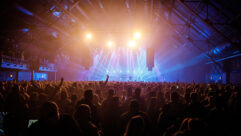On this edition of the SVC Podcast, Contributing Editor Bennett Liles talks with Devin Sheets, lead design and installation technician for Alpha Sound in Salem, Oregon. Devin discusses the installation of a Yamaha/Nexo sound system in the Portland Center Stage Theater. He details the tuning of the system and the selection of a Yamaha QL5 digital mixer at the front of house position.
Links of Interest:
· Alpha Sound in Salem, Oregon
· Nexo Geo M6 line array used in the main theater
· Yamaha MTX matrix processors
· Yamaha QL Series digital audio consoles
At the Portland Center Stage Theater they had patched and patched the sound system to keep it going and they finally had to have a completely new solution. Alpha Sound in nearby Salem, Oregon came in with a Nexo/Yamaha sound system that can handle anything the venue’s schedule can throw at it. Lead design and installation technician Devin Sheets is going to give us the lowdown on how it all went, right here on the SVC Podcast.
And we’re reaching all the way out west to Oregon this week for Alpha Sound and it’s good to have you with us Devin.
Thanks for having me.
So tell us about Alpha Sound. How did that outfit get started and what got you into doing live sound installations?
Yeah, well Alpha Sound has been in business for 40 years. It was started by my father, Duane Sheets, our company president. We’re located in Salem, Oregon and we mainly service the Pacific Northwest, but on occasion extend around the country. And we’ve even recently done some work abroad in Spain and Germany and Switzerland. The nature of the company has changed a lot through the decades. It began as a recording studio, which turned into a retail music store. And the live sound division really took off in the late 80’s and 90’s. At one point in the mid-90’s we actually had the largest EAW 850 rig west of the Mississippi. So in the 2000’s we became a fully exclusive Yamaha/Nexo house and really switched our focus toward a combination of installations and corporate work. And we still enjoy doing our annual festivals and the occasional rock show, but the company for the last 20 years now has really been known as a kind of boutique outfit. We take on a limited number of projects that we mostly enjoy doing and that we know we can do uniquely well. So for example, we’ll take on a highly creative an experimental project like amplifying classical music outdoors and in surround sound. We’ve invented a number of proprietary techniques to help push the boundaries of what is possible to achieve through live amplification, and we really view microphones and speakers as kind of the next great tool in the advancement of the musical arts. [Timestamp: 2:21]

Well, that’s great that you can do the specific types of projects that you most enjoy doing. A lot of AV companies have to take what they can get and you’re in an enviable position. This was a Yamaha/Nexo install in a place called the Armory. What kind of place is that? What different areas does it have in it?
Yeah, so the Armory is a historic building in downtown Portland that has been converted into a multifunctional theater venue. It’s known as Portland Center Stage Theater, or just PCS. There’s a main theater and also a secondary smaller theater downstairs, various rehearsal halls, offices, and it also has an amazing set of lobby areas that get used for independent events. [Timestamp: 3:04]
There are the Portland Center Stage Theatre Group out there and that place looked to me to have so many different spaces and things you can do so what kinds of events do they have there? Is it all theatrical?
It’s mostly theater-related events, but there’s a fair amount of usage for corporate events and parties and whatnot. Almost every area of the building is being used on any given day. It’s not uncommon for there to be multiple events happening kind of all at once. [Timestamp: 3:30]
And they probably don’t have a huge tech crew there so everything has to be reliable because if several things went bad in different areas at the same time you could quickly find yourself over your head. What things were they aiming to fix with this project? Alpha Sound has been helping them out for quite some time.
Yeah. We’ve had a long relationship with PCS; renting them equipment for shows and helping to improve their sound in various ways within budget constraints. It was a typical situation where the system was comprised of multiple layers of Band-Aids just to try to get by as components would fail. It was hard to hear and understand the vocals at times, especially in a heavy mix of instruments and content. Their resident sound designer, Casi, had done an incredible job of making the system that she was given work its best, but we eventually did a demo of some Nexo line arrays in there and that really pushed them in a direction to reevaluate the entire situation with their sound. After really hearing what it could sound like with new equipment it was hard to go back. And after that we were asked to come in and do the full installation, and a lot of that was due to Casi’s influence. She really pushed hard for that demo. They’re lucky to have her. [Timestamp: 4:46]

And the main theater, I believe it’s called the U.S. Bank Main Stage. You gave them the Yamaha/Nexo system and so the Nexo advantage was what?
Yeah, well Nexo provides a simple but very powerful software program for venue system design and acoustic prediction. Actually, the design process was really simple. Nexo only makes a few products, but each one, I think, if probably the best in its class in the industry. So we spec’d an M6 line array mainly because it was small, and also put in some PS15 speakers for a center cluster. For amplification we used the NX amplifiers that were actually designed by Yamaha and Nexo together. So if you think of a regular amplifier as a rotary phone, these amps are like smart phones. When you plug in a Nexo speaker it knows every last little thing about that speaker and has some really interesting ways of gathering real-time data about how the speaker is behaving. So their protection algorithms are extremely sophisticated and you can really get the most out of the speaker from an SPL standpoint without really sacrificing any audio quality or really having to worry about causing serious damage to the speakers. It’s great in situations where you have guest engineers coming in and who knows how hard they’re going to push the systems? With the Nexo stuff you just know it will always sound great and it will last a long time. [Timestamp: 6:05]
And one of the critical spots on any system like this is where the human operators and the system hardware meet. Of course, that’s at the control point and in this one there’s a Yamaha QL5 digital mixer right there.
Yeah. The Yamaha consoles are very intuitive and easy to configure. Casi really wanted to have the full range of flexibility and features that a digital console brings to the table, especially with the Dante networking which is taking the industry by storm – and for good reason. The console is also priced really well in the market for what it will do and how it will sound. That’s a big reason why we chose it. Yamaha also has incredible tech support. They’re really interested in making sure that their products not only get sold, but then also work and sound their best in the field. As far as the users go, it’s really nice having 32 faders all right in front of you with, of course, the full 64 channels a button away, and four customizable fader banks with a nice big touch screen. Thirty-two mic pre’s on the console itself as well as the full Dante capability, I mean it’s a lot packed into a console of its size. And they’re super-reliable. We’ve never had a console crash during a show or really ever had any serious glitches or problems. I would say that the Yamaha is the strongest brand in the industry today. I mean, anybody that just came back from NAM could see this. [Timestamp: 7:28]
I don’t think you would find many arguments against that. You depend on a Yamaha mixer not only to keep working but also to be flexible and easy to figure out. That’s a balance mixer designers are always dealing with. So when you got this all rigged and hung and the sweat work was done, how did you go about tuning and tweaking the system?
You know [Chuckles], I used to use a lot of software to tune systems but these days I use my ear. And every once in a while I bust out the software when I’m trying to do experimental work or some serious troubleshooting. I’ve actually found that there’s a discrepancy between the sound of systems which have been tuned to be perfectly flat and then the way that I end up tuning the system after actual use. So I always give the client an A/B comparison of the work I’ve done and then let them choose which tuning they think sounds the best, and so far I’ve not had anyone tell me they like the traditionally flat tuning better. So I’ve pretty much moved away from that method and just rely on my ears. [Timestamp: 8:24]
Probably quicker and more fun to do it that way especially when you turn the local operators loose on it and let them see what they can do. I’m looking forward to Part 2 where we’ll get into the building-wide paging system you put in and the iPad wireless control. We’ve been talking to Devin Sheets, lead design and installation technician with Alpha Sound in Salem, Oregon. See you again next week.
Portland Center Stage has what it needs now to handle all of their shows with their new Yamaha/Nexo system. Next week Devin is going to tell us about the building-wide paging system that Alpha Sound also installed. Get back with us for that one on the next SVC Podcast.










